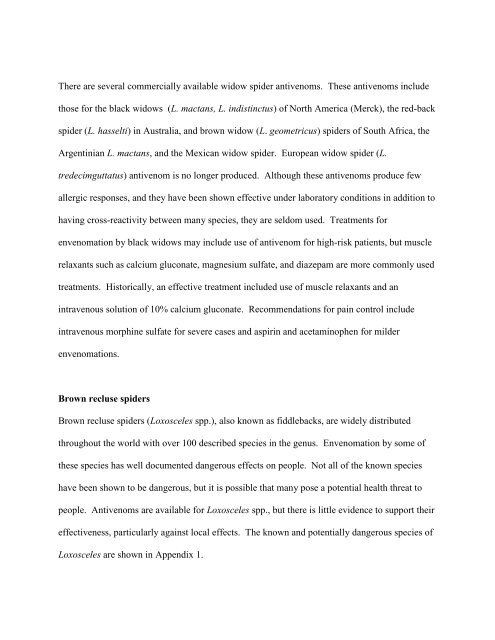Field Guide to Venomous and Medically Important Invertebrates ...
Field Guide to Venomous and Medically Important Invertebrates ...
Field Guide to Venomous and Medically Important Invertebrates ...
You also want an ePaper? Increase the reach of your titles
YUMPU automatically turns print PDFs into web optimized ePapers that Google loves.
There are several commercially available widow spider antivenoms. These antivenoms include<br />
those for the black widows (L. mactans, L. indistinctus) of North America (Merck), the red-back<br />
spider (L. hasselti) in Australia, <strong>and</strong> brown widow (L. geometricus) spiders of South Africa, the<br />
Argentinian L. mactans, <strong>and</strong> the Mexican widow spider. European widow spider (L.<br />
tredecimguttatus) antivenom is no longer produced. Although these antivenoms produce few<br />
allergic responses, <strong>and</strong> they have been shown effective under labora<strong>to</strong>ry conditions in addition <strong>to</strong><br />
having cross-reactivity between many species, they are seldom used. Treatments for<br />
envenomation by black widows may include use of antivenom for high-risk patients, but muscle<br />
relaxants such as calcium gluconate, magnesium sulfate, <strong>and</strong> diazepam are more commonly used<br />
treatments. His<strong>to</strong>rically, an effective treatment included use of muscle relaxants <strong>and</strong> an<br />
intravenous solution of 10% calcium gluconate. Recommendations for pain control include<br />
intravenous morphine sulfate for severe cases <strong>and</strong> aspirin <strong>and</strong> acetaminophen for milder<br />
envenomations.<br />
Brown recluse spiders<br />
Brown recluse spiders (Loxosceles spp.), also known as fiddlebacks, are widely distributed<br />
throughout the world with over 100 described species in the genus. Envenomation by some of<br />
these species has well documented dangerous effects on people. Not all of the known species<br />
have been shown <strong>to</strong> be dangerous, but it is possible that many pose a potential health threat <strong>to</strong><br />
people. Antivenoms are available for Loxosceles spp., but there is little evidence <strong>to</strong> support their<br />
effectiveness, particularly against local effects. The known <strong>and</strong> potentially dangerous species of<br />
Loxosceles are shown in Appendix 1.

















